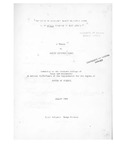| dc.description.abstract | A six-month study was conducted in southeastern Kenya to determine the influence of varying bush canopy cover on dietary selection and nutrition of mature esophageally fistulated heifers. Replicated moderately stocked paddocks (2.25 ha) each, were grazedonedav even' 28-30 days from June to November, 1982. Treatment paddocks were designated light, moderate and heavy bush conditions with 12.8, 31.5 and 49.8% total canopy cover, respectively. Acacia Senegal, Cordia ovalis and Grewia villosa were the primary woody vegetation whi ch created treatment effect. Digitaria macroblephara increased in composition with increasing canopy cover while Chloris roxburghiana decreased.
Heifer diets were dominated by grass and grasslikes irrespective of seasons. Animals ate more grass, less forbs and least browse across pastures and in all seasons. Animals consumed less grass and grasslike as canopy cover increased. Digitaria macroblephara and Chloris roxburghiana dominated animal diets throughout the study. Although more than 18 woody species were on offer only three species, Acacia Senegal, Hermania alhiensis and Boscia sp. were selected by animals. These species constituted less than 1% of the animal diets. When green, animals ate Commelina bengalensis and TaJinum kafrum forbs along with grasses. Diets
during the long dry season were not diverse as for the wet season.
Digitaria macroblephara, Chloris roxburghiana and Sporobolus
pellucides were the major grass selected by the heifers, whereas Bothriochloa inscnipt a was least preferred grass. Freference ratios indicated that cattle preferred grass and grasslikes, forbs and browse in that order. Boscia sp. was the most preferred browse while Talinum kafrum, Commelina bengalensis and Asparagus sp. were the most preferred forbs. Although Acacia sp. and Hermania alhiensis dominated the studv site, they ranked least in diet preference order. Further ecological research is needed to determine the influence by these woody species on herbage production in order to recommend the economic advantage of these dominant species.
All the dietary nutrients met the maintenance requirements of the cattle throughout the study, except for crude protein which was deficient in August and September. There appears to be potential problem for rumen carbon:nitrogen (C:N) balance in cattle due to the relatively high DE values in relation to nitrogen content of the diets. | en_US |



